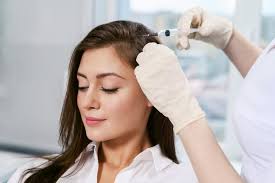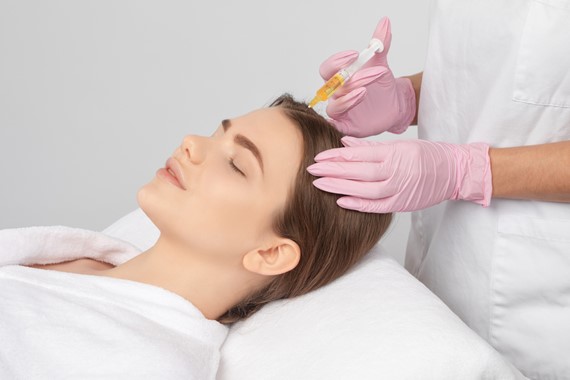1. Introduction: Why PRP Therapy is the Future of Hair Loss Treatment
When it comes to hair loss treatments, many people still believe that PRP therapy for hair loss is just another gimmick or a passing trend. After all, there are countless “miracle” solutions out there, from hair loss shampoos to pills that promise to restore hair growth overnight. However, PRP (Platelet-Rich Plasma) therapy has been gaining traction as a legitimate, scientifically-backed treatment option for hair loss, and it’s definitely more than just a passing trend.
PRP therapy for hair loss is a non-surgical procedure that harnesses your body’s natural healing processes to promote hair growth. Unlike pills or topical solutions, PRP for hair regrowth works directly with your body’s own plasma to stimulate hair follicles and encourage the growth of healthier, thicker hair.
Why is PRP Therapy Gaining Popularity?
As more people seek out effective, non-invasive treatments for hair loss, PRP therapy for thinning hair is standing out as a top contender. The beauty of PRP lies in its ability to regenerate hair follicles using the patient’s own blood—making it a natural, safer alternative to some harsher treatments like hair transplants. This non-surgical solution can help people experiencing male pattern baldness, thinning hair, and other forms of alopecia. But what makes it even more appealing is that it works for both men and women.
PRP for hair loss is a growing trend in the hair restoration industry because it offers proven results without the need for invasive surgery. The therapy not only helps with hair regrowth but can also improve hair thickness and overall scalp health. Whether you’re dealing with receding hairlines, hair thinning, or bald spots, PRP scalp treatment is showing promise as a game-changing solution.
2. What is PRP Therapy for Hair Loss?
If you’re considering PRP therapy for hair loss, you might be wondering exactly what it is and how it works. At its core, PRP therapy is a medical procedure that uses your body’s own blood components to help regenerate and promote the growth of hair. Let’s break it down step by step.
How PRP Therapy Works for Hair Loss
PRP stands for Platelet-Rich Plasma, which is a component of your blood that contains a high concentration of platelets. Platelets are responsible for healing tissues and stimulating cell growth. During the PRP hair restoration procedure, blood is drawn from your body, and the platelets are separated from the other blood components. This rich plasma is then injected directly into your scalp, specifically targeting the areas affected by hair thinning or loss.
The Science Behind PRP for Hair Regrowth
The idea behind PRP therapy for hair loss is that the growth factors in your platelets can stimulate dormant or damaged hair follicles, encouraging them to become active again. This process promotes hair follicle regeneration and improves the overall health of the scalp. As the plasma is injected into the scalp, it encourages the growth of new, thicker hair.
Studies have shown that PRP for hair thinning can increase hair density and improve the quality of hair in patients who undergo regular treatments. This is why PRP therapy for hair loss has become so popular, particularly among individuals looking for a non-invasive solution to combat hair thinning.
How Long Does PRP Therapy Take?
The PRP process is fairly quick, usually taking around 60-90 minutes in total. During the procedure, a healthcare professional will draw blood from your arm (similar to a blood test), then use a centrifuge machine to separate the platelets from the rest of the blood. Once the platelet-rich plasma is isolated, it is carefully injected into the scalp using a fine needle.
Most patients report minimal discomfort during the treatment, with the procedure being well-tolerated overall. The number of sessions required varies depending on the individual and the extent of their hair loss. Typically, a series of 3-4 sessions is recommended over a few months, followed by maintenance sessions every 6-12 months.
What Makes PRP Different from Other Hair Loss Treatments?
Unlike other hair loss treatments that rely on chemicals, topical solutions, or surgery, PRP therapy for hair loss uses your own blood, which means there’s minimal risk of allergic reactions or complications. However, certain health conditions may affect your eligibility for treatment. For example, people with blood disorders, such as thrombocytopenia (low platelet count) or blood clotting issues, may not be good candidates for PRP therapy due to the way the procedure relies on platelets to promote healing.
Many people who have tried oral medications for hair loss, such as finasteride or minoxidil, find that these solutions may have unwanted side effects or may not deliver lasting results. On the other hand, PRP therapy has shown to be a relatively safe treatment with minimal side effects. The fact that it uses your own blood means that the risk of adverse reactions is significantly reduced.
In comparison to a hair transplant, which involves moving hair follicles from one part of your scalp to another, PRP therapy is far less invasive. There’s no need for surgery, stitches, or a lengthy recovery period. For many people, the convenience and reduced downtime of PRP therapy for hair loss make it a much more appealing option than a full-fledged hair transplant.
Why Choose PRP Therapy for Hair Loss?
As a non-surgical solution, PRP therapy for thinning hair offers a unique advantage for those looking to restore their hair without going under the knife. In addition to being less invasive, PRP for hair regrowth has shown promising results for people at different stages of hair loss, especially those who are experiencing early to moderate thinning. The treatment works for both men and women, making it a versatile option for anyone struggling with hair loss or thinning.
Moreover, PRP has a proven track record in helping people regenerate healthier, thicker hair, making it a highly recommended treatment by many professionals in the field of dermatology and hair restoration. The minimal side effects, fast recovery, and long-term results make it an attractive option for those looking to restore their hair without invasive procedures.
3. Who Can Benefit from PRP Therapy for Hair Loss?
If you’re considering PRP therapy for hair loss, you’re probably wondering whether it’s the right treatment for your specific hair situation. While PRP therapy has shown excellent results for a variety of hair loss types, not everyone is a perfect candidate. Understanding who can benefit the most from this treatment is crucial before making a decision.
PRP for Hair Regrowth: Who Is It Ideal For?
PRP therapy works best for people who are experiencing early stages of hair thinning or hair loss. If you’re noticing a receding hairline, thinning hair, or the first signs of male pattern baldness, you might be an ideal candidate for PRP therapy. Many patients who are experiencing hair thinning treatment or hair loss due to androgenic alopecia (common in both men and women) have seen remarkable results with PRP injections.
Men with Male Pattern Baldness (MPB)
One of the most common types of hair loss is male pattern baldness (MPB), which affects a large percentage of men as they age. Men in the early to moderate stages of MPB, particularly those with thinning hair on the crown or receding hairline, are likely to see significant improvement with PRP hair restoration. PRP injections for hair regrowth can stimulate hair follicles that are still alive and active, potentially improving the thickness and density of hair in the affected areas.
Women with Female Pattern Hair Loss
Many women experience hair thinning as they age, particularly around menopause. Female pattern hair loss (FPHL) can result in diffuse thinning across the scalp. Fortunately, PRP therapy for female hair loss has been shown to promote hair growth and density in women as well. Since the treatment uses natural growth factors, it’s safe and effective for most women who experience thinning hair or alopecia. If you’re dealing with female hair thinning treatment, PRP therapy could be a game-changer.
People with Early-Stage Alopecia Areata
Another condition that PRP therapy can help with is alopecia areata, an autoimmune disorder where hair falls out in small, round patches. While PRP therapy for alopecia is still being studied, early research has shown that PRP can promote hair regrowth in people suffering from this type of hair loss. PRP hair regrowth helps rejuvenate the affected areas of the scalp and stimulates dormant follicles to grow new, healthy hair.
What About Advanced Hair Loss?
It’s important to note that while PRP therapy for hair thinning can work wonders in early-stage hair loss, it may not be as effective for people who are experiencing advanced hair loss or complete baldness. If a person has lost a significant amount of hair and the follicles are no longer active or healthy, PRP therapy might not yield the desired results.
However, that doesn’t mean there aren’t options. If you’re dealing with severe hair loss, hair transplants might be a more suitable option. Still, some patients with advanced stages of hair loss choose to combine both treatments—PRP therapy alongside hair transplants—to promote the health and regeneration of the transplanted hair follicles.
Is PRP Therapy Safe for Everyone?
The great news about PRP therapy is that it uses your own blood, which means there’s a minimal risk of allergic reactions or complications. However, certain health conditions may affect your eligibility for treatment. For example, people with blood disorders, such as thrombocytopenia (low platelet count) or blood clotting issues, may not be good candidates for PRP therapy due to the way the procedure relies on platelets to promote healing.
Additionally, if you have an active infection on your scalp or severe scalp conditions, such as psoriasis or eczema, it’s important to consult with a healthcare professional before proceeding with PRP hair restoration.



Leave Your Comment